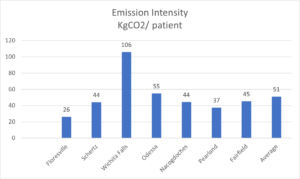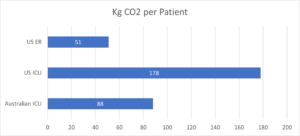
In the pulse-pounding environment of emergency rooms (ERs), where every second counts and lives hang in the balance, a hidden player quietly shapes the healthcare narrative—emission intensity. Picture this: the average emission intensity in these critical healthcare units is 51 Kg CO2 per patient. As we delve into the depths of our groundbreaking research, we uncover the intricate narrative embedded within the framework of emergency healthcare. Join us on an extraordinary journey as we explore the emission intensity of U.S. emergency rooms, forging a path toward a future of carbon-conscious healthcare. This is not just a statistic; it’s a call to action, a pivotal moment in the intersection of urgent care and climatic responsibility.
Exploring Purpose – The Heart of Our Research
The objective of this research is to explore the emission intensity of healthcare facilities, specifically emergency rooms, recognizing a notable gap in existing literature where comprehensive exploration of this critical aspect has been lacking. By bridging this knowledge void, the study seeks to uncover and understand the intricacies of emission intensity within ERs, offering insights into the environmental impact of urgent healthcare practices.
From Haze to Clarity – Grasping the Essence of Emission Intensity
Emission intensity refers to the amount of greenhouse gases emitted per unit of activity, output, or another relevant metric. In a healthcare context, emission intensity could be expressed as the amount of carbon dioxide (CO2) or other greenhouse gases emitted per patient treated, per square foot of facility space, or per unit of medical services provided. Emission intensity facilitates more meaningful comparisons between different facilities by normalizing the total emission data into a specific metric. This normalization process provides a standardized basis for assessment, allowing for fair and accurate comparisons that account for variations in facility size, patient volume, and operational characteristics.
Behind the Scenes – Revealing Our Research Methods
We focused our study on seven emergency rooms within the ProCare group in Texas, U.S, aiming to understand their emission intensity. The understudy ERs are Emergency Care of Floresville, Schertz Cibolo Emergency Clinic, ER Now Wichita Falls, Excel ER Odessa, Excel ER Nacogdoches, Fairfield ER and Texas Emergency Care Pearland.
To assess their climatic impact comprehensively, we calculated Scope 1, 2, and 3 emissions for a year, offering a detailed insight into the total carbon footprint of each ER.
For the calculation of emission intensity, we opted for a simple and relevant metric – the total number of patients. By dividing the total emissions in kilograms of CO2 by the number of patients, we aimed to express emission intensity in terms of kilograms of CO2 per patient, offering a clear and meaningful measure of the healthcare facility’s carbon footprint per individual treated.
Insights at a Glance – Our Research Findings
Our research has uncovered compelling findings that shed light on the emission intensity landscape within ERs. The average emission intensity, a key metric in our study, has been calculated at 51 Kg CO2 per patient. Let’s delve into the individual emission intensities of each ER through the presented chart.

The chart vividly displays the variability in emission intensity among the seven ERs. The variations in emission intensity across all ERs arise from differences in facility size, and data variations. These key factors play a pivotal role in shaping the unique emission profiles of each emergency room. Larger facilities may inherently generate higher emissions, while data variations, stemming from diverse operational practices contribute to unique carbon impact of each ER. Understanding these variations can guide efforts to identify best practices and areas for improvement in achieving a more sustainable healthcare model.
During the calculation of emission intensities for each ER, our research also revealed significant emission hotspot. Among the various contributing factors, electricity consumption emerged as the primary source of emissions across most ERs.
From ICUs to ERs – A Comparative Analysis of Emission Intensity
In the ever-evolving landscape of healthcare sustainability, our research takes a global stride, drawing comparisons between previous studies and our groundbreaking findings. A prior investigation into Australian and US Intensive Care Units (ICUs) investigated a per patient carbon footprint of 88 and 178 Kg respectively. In stark contrast, our study focuses on the dynamic realm of US Emergency Rooms (ERs), calculating emission intensity to reveal a remarkably lower figure – 51 Kg CO2 per patient. This comparative exploration not only underscores the diversity in healthcare practices but also prompts a closer look at the intricacies shaping emission intensity in different critical care settings across the borders. ICUs exhibit higher emissions compared to ERs due to the greater energy consumption associated with specialized machines such as ventilators, monitors, and other life support devices and constant need of HVAC system and lighting. The intricate and high-tech medical equipment in ICUs demands more energy consumption, contributing to elevated emission levels. While the ERs also have medical equipment and lighting, it does not require the same level of continuous, intensive monitoring and life support as an ICU. As a result, the emission intensity is lower.
The following chart gives a comparison between emission intensities of ER and ICUs.

Closing the Chapter – Key Takeaways
The revelations from our research provide a comprehensive understanding of the emission landscape in ERs and paving the way for targeted and impactful sustainability measures. The calculated average emission intensity of 51 Kg CO2 per patient stands as a pivotal metric, offering a standardized measure for evaluating and comparing the carbon footprint of ERs. This benchmark not only quantifies the carbon footprint but also sets the stage for the establishment of sustainable practices, guiding healthcare administrators towards measurable goals for emission reduction.
In light of the significant contribution of electricity consumption to emission intensity, exploring alternative energy sources is imperative for sustainable healthcare practices. Our recommendations involve switching to renewable energy options and integration of energy-efficient technologies, lighting, HVAC systems, and appliances that can substantially reduce electricity demand. These initiatives not only decrease the carbon footprint associated with electricity but also position ERs as champions of sustainable healthcare.
__________________________


